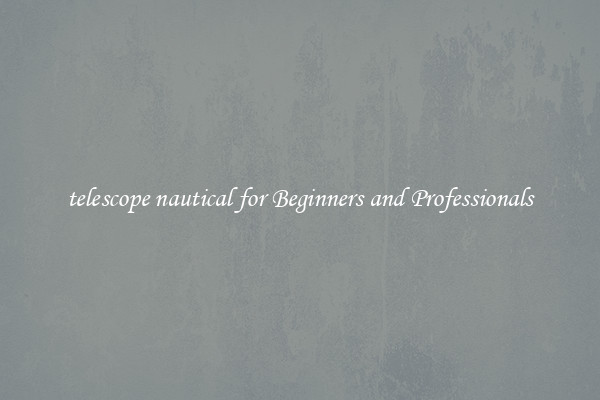telescope nautical for Beginners and Professionals
Telescope Nautical: A Guide for Beginners and Professionals

Telescope nautical, also known as marine telescopes, have been an essential tool for sailors and navigators for centuries. These telescopes are specifically designed to meet the needs of those on the open sea, providing clear and magnified views of distant objects. Whether you're a beginner or a seasoned professional, here's a guide to help you make the most of your telescope nautical.
For beginners, understanding the basics of telescope nautical is crucial. These telescopes are typically made of brass or bronze, which makes them durable and resistant to the corrosive effects of saltwater. The lenses are specially coated to provide a clear view, even in challenging weather conditions. When selecting a telescope nautical as a beginner, it's important to look for a model with lower magnification. Higher magnification may result in shaky images, making it challenging to focus on distant objects from a moving boat.
Before using your telescope nautical, it's essential to know how to set it up and calibrate it. Most models come with an adjustable tripod, allowing you to stabilize the telescope on a flat surface. Adjust the tripod legs to ensure stability. Once the telescope is stable, adjust the focus by turning the focus wheel until the image is clear and crisp. It may take some practice, but with time, you'll become more proficient.
For professionals, a telescope nautical serves various purposes, from navigation to spotting other vessels or landmarks. To make the most of your telescope nautical, it's essential to understand how to use its additional features. Many models come with built-in compasses, which are invaluable for determining bearings and directions. Familiarize yourself with the compass and its markings to make accurate readings.
Another essential feature for professionals is the reticle. The reticle, also known as a crosshair, is a set of fine lines or markings in the eyepiece. These help sailors and navigators measure the distance, size, or position of objects in relation to each other. Learning to use the reticle effectively will greatly enhance your navigational skills.
Regardless of whether you're a beginner or a professional, proper maintenance of your telescope nautical is crucial. After each use, clean the lenses with a lens cleaner or a microfiber cloth to remove any dirt or smudges. Always store your telescope in a protective case to prevent damage when not in use. It's also advisable to periodically check for any signs of wear and tear and get it serviced if needed.
In conclusion, a telescope nautical is an invaluable tool for both beginners and professionals in the maritime world. Understanding its features, learning to set it up, and practicing its use will greatly enhance your navigation skills. Whether you're using it for celestial observations or spotting distant landmarks, a telescope nautical opens up a world of possibilities on the open sea.

View details

View details

View details

View details




